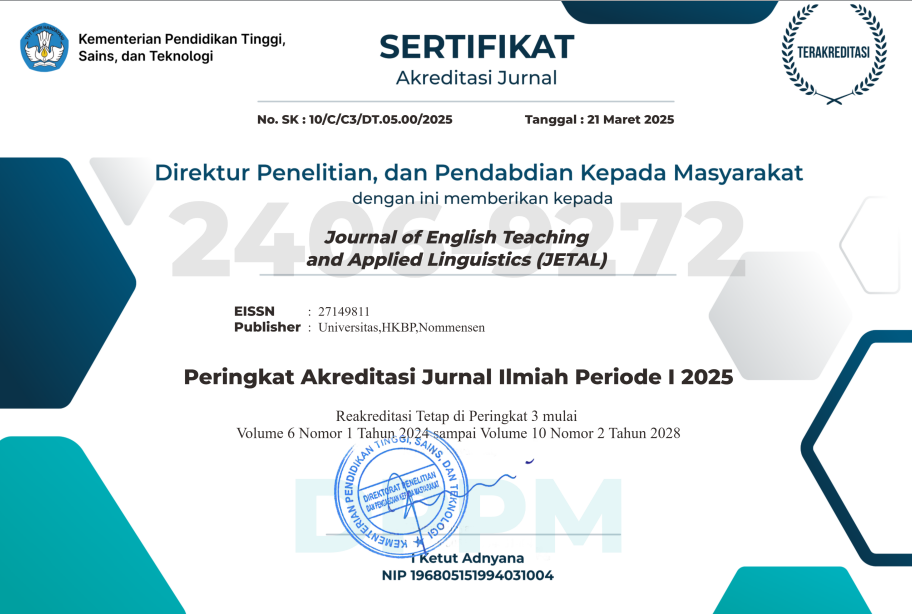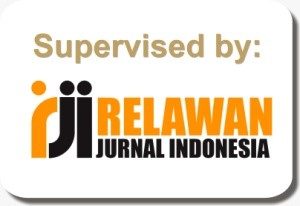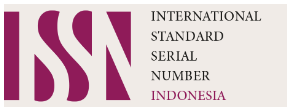Translating Text of Cultural Terms in Mangupa A Mandailing Formal Traditional Marriage Counseling Ceremony
Abstract
Mandailing is a region in North Sumatra one of province in Indonesia that has and preserves traditional culture. One of the specific aspects of traditional Mandailing culture is process of marriage. Mangupa as the final or Mandailing final marriage ceremony is a very interesting ceremony. It is delivered verbally and by using various kinds of objects as symbols which is realized in a relatively long text and uses many cultural words and expressions that require certain translation strategies and techniques. Objective of the research is to find out translation techniques which are used by the translator in transalting cultural terms of Mangupa into English and to explain how the quality of translation in transalting cultural terms of Mangupa into English. This research uses qualitative method which applies descriptive approach to assess data with documents and key informants as source of data. Research findings identifies that translation techniques used by the translator in transalting cultural terms of Mangupa into English consists of three technique. They are 11 data are single translation technique (18.64%), 36 data are couplet translation technique (61.01%), and 12 data are triplet translation technique (20.03%). The researcher analyzed 59 data of cultural terms which is found in the text Mangupa a formal traditional ceremony in Mandailing. The text Mangupa consists of 22 paragraphs and 37 in the form of verses. The quality of translation shows that The accurate translation consists of 42 data (71.18%) and less accurate translation is 17 data (28.18%). The acceptable translation is 47 data (79.66%) and less acceptable is 12 data (20.33%). The high readability translation is 30 data (50.84%) while medium readability translation is consist of 29 data (49.15%). It is identified that the quality of translation is accurate, acceptable and has a high degree of readability. It means that the quality of translation is very good.
References
Basnett, M. (1980). Translation Studies. New York: Mathuen & Co Ltd. pp.2.
Lubis, S. (2009). In his thesis entitled Penerjemahan Teks Mangupa Dari Bahasa Mandailing Ke Dalam Bahasa Inggris. USU: Medan.
Lubis, P. (2007). “Pembentukan Huta di Mandailing”, dalam Sinondang Mandailing. Medan, 14 Juni.
Miles., et al. 2014. Qualitative Data Analysis. USA: SAGE Publications, Inc. pp.31 – 33.
Molina, L. & Albir, A. (2002). Translation Technique Revisited. A Dinamic and Functional Approach. Meta Journal, 15(7), 499 – 512.
Nababn, et al. (2012). Pengembangan Penilaian model kualitas terjemahan. Kajian Linguistik dan Sastra Journal, 24 (1), 39 – 57.
Nasution, P.(2001). Acara Mangupa di Mandailing, Angkola, Sipirok dan Padang lawas. Medan: Yayasan Parsarimpunan ni Tondi.
Nasution, P. (2005). Adat Budaya Mandailing dalam Tantangan Zaman. Medan: Forkala.
Newmark, P. (1988). A Textbook of Translation. New York: Prentice Hall International. pp.6,19,45 - 46.
Nida, E. (1969). Toward a Science of Translating. Leiden, Netherlands: E.J. Brill. pp.12.
Owen, R. (1998). The Translator’s Handbook, 3rd Edition. London: Aslib, the Association for Information Management Information House. pp.5.
Richard, M. (1985). Composition, A Course Writing and Rhetoric. New York: College of the University of Chicago. pp.420.
Ritonga, D. (1986). Anak Na Dangol Ni Andung. Jakarta: Departemen Pendidikan dan Kebudayaan. pp.1 – 115.
Salleh, Muhammad Haji. “A Malay knight Speaks the Whiteman’s Tongue: Notes on Translating the Hikayat Hangtuah, dalam Indonesia and the Malay World”, Vol.34, No. 100 November 2006, pp. 395-405.
Sari W.P. (2010). In her thesis entitled Translation Technique and Translation Accuracy of English Translated text of Tourism Brochure in Tanah Datar Regency.
Silalahi, R. (2009). Dampak tehnik, Metode, dan Ideologi Penerjemah pada Kualitas Terjemahan Teks Medical – Surgical Nursing dalam Bahasa Indonesia. (Unpublished Doctoral dissertation). Universitas Sumatera Utara: Medan, Indonesia.
Simatupang, M. (2000). Pengantar Teori Terjemahan. Jakarta: Ditjend Dikti, Depdiknas.
Sinde (2012). In her thesis entitled Analysis Teknik, Metode dan Ideologi Penerjemahan Terhadap Buku Cerita Anak Bilingual “Four Funny Animal Stories.
Sipayung, R. (2016). Terjemahan Teks Acara Makhioui Pada Pesta Pernikahan Adat Simalungundalam Bahasa Indonesia. (unpublished Doctoral dissertation).Universitas Sumatera Utara: Medan, Indonesia.
Sipayung, et al. (2016). Research on Translated Text of Makhioui in Simalungun Wedding Ceremony into IndonesiaLanguage. Language and Linguistic International journal SciencePG 4(1), 30-39.
Suryawinata, Z. & Sugeng H. (2003). Translation: Bahasan Teori dan Penuntun Praktis Menerjemahkan. Yogyakarta: Kanisius.
Steiner. G. (1994). AfterBabel: Aspects of Language and Translation. Oxford University Press. pp.103.
Yarahmadzehi, N. & Moghadam, M. (2017). Shifts in Coordinate and Correlative Conjunctions in Translation from English to Persian Language. International Journal of English Language & Translation Studies. 5(4). 07-13.
Authors retain copyright and grant the journal right of first publication with the work simultaneously licensed under a Creative Commons Attribution-ShareAlike 4.0 International License (CC BY-SA 4.0) that allows others to share the work with an acknowledgment of the work's authorship and initial publication in this journal.
Authors are able to enter into separate, additional contractual arrangements for the non-exclusive distribution of the journal's published version of the work (e.g., post it to an institutional repository or publish it in a book), with an acknowledgment of its initial publication in this journal.
Authors are permitted and encouraged to post their work online (e.g., in institutional repositories or on their website) prior to and during the submission process, as it can lead to productive exchanges, as well as earlier and greater citation of published work (See The Effect of Open Access).






